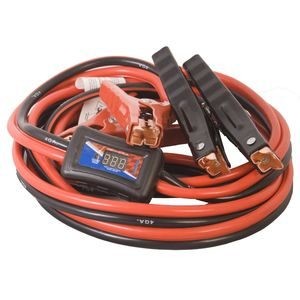Jump starting a car is a common necessity for drivers, but the thought of doing it in the rain can raise safety concerns. Many wonder, Can You Jump Start A Car In The Rain without risking electric shock or further damage? The answer is reassuring: yes, you can safely jump start your car even when it’s raining, provided you take the right precautions.
While water and electricity are a well-known dangerous combination, your car’s electrical system is designed to operate safely in wet conditions. Moreover, the car’s electrical system is low voltage. Direct contact with battery terminals, even with bare hands, poses minimal risk of electric shock. However, it’s crucial to understand that while the risk of electrocution is low, other dangers exist when jump starting a car in the rain. This guide will walk you through the steps to safely jump start your car in wet weather and highlight potential hazards to avoid.
Safety First: Understanding the Risks and Realities
The primary concern when jump starting a car in the rain isn’t usually electric shock. Car batteries operate at 12 volts, which is not typically enough to cause a dangerous shock. The real risks in wet conditions are related to reduced visibility, slippery surfaces, and the potential for water to interfere with the jump starting process if you’re not careful.
Water can create a path for stray current, and while not life-threatening in a car’s low-voltage system, it can still lead to minor discomfort or inefficient current flow during the jump start. Additionally, moisture on battery terminals can hinder a good connection, making the jump start attempt unsuccessful. Therefore, the focus should be on minimizing water interference and ensuring a secure and correct connection of the jumper cables.
Step-by-Step Guide to Jump Starting in the Rain
Jump starting a car in the rain follows the same basic procedure as in dry conditions, but with added attention to keeping things dry and safe. Here’s a detailed step-by-step guide:
Step 1: Gather Your Supplies
Before you even position the cars, make sure you have everything you need readily available. This includes:
- A Working Vehicle: This is essential to provide the power to jump start your dead battery.
- Jumper Cables: Ensure they are in good condition, without any frayed wires or damaged clamps.
- Gloves (Optional but Recommended): Gloves, especially rubber or insulated ones, can provide an extra layer of protection and improve grip in wet conditions.
- A Dry Towel or Cloth: Absolutely crucial for drying off battery terminals and hands.
[ Jumper Cables for safe car jump start in rainy weather ]
Step 2: Position and Prepare the Cars
Safety starts with positioning your vehicles correctly:
- Stable and Safe Location: Park both cars on a level, stable surface, away from traffic and, if possible, out of direct standing water or puddles.
- Turn Off Both Ignitions: Completely turn off the ignition of both the car with the dead battery and the car providing the jump start. Engage the parking brakes for both vehicles.
- Hood Access: Ensure you can safely open the hoods of both vehicles and access the batteries.
Step 3: Dry the Battery Terminals
This is a crucial step when jump starting in the rain:
- Locate the Battery: Find the battery terminals in both vehicles.
- Wipe Dry: Use your dry towel or cloth to thoroughly wipe dry the terminals of the dead battery. This removes any water that could interfere with the connection. Also, wipe your hands to ensure a good grip on the jumper cables.
Step 4: Connect the Jumper Cables Correctly
Connecting the jumper cables in the correct sequence is vital for safety:
- Positive to Positive (Red Cable First): Attach one red clamp to the positive (+) terminal of the dead battery. It’s usually marked with a “+” sign or a red cover.
- Donor Battery Positive: Attach the other red clamp to the positive (+) terminal of the working car’s battery.
- Negative to Donor Battery (Black Cable): Connect one black clamp to the negative (-) terminal of the working car’s battery. It’s usually marked with a “-” sign or a black cover.
- Negative to Ground (Black Cable, Dead Car): Attach the final black clamp to a clean, unpainted metal surface on the dead car. This could be a bolt, a metal strut, or part of the engine block, but NOT the negative terminal of the dead battery. Grounding to the frame minimizes the risk of sparks near the battery, which can be hazardous if hydrogen gas is present.
[ Portable jump starter as an alternative to jumper cables in the rain ]
Step 5: Start the Engines
Follow this sequence to start the cars:
- Start the Working Car: Start the engine of the car with the good battery and let it run for a minute or two. This allows it to send charge to the dead battery.
- Attempt to Start the Dead Car: After a minute, try to start the car with the dead battery.
- Let Both Engines Run: Once the dead car starts, let both engines run for several minutes. This helps recharge the dead battery.
Step 6: Disconnect the Cables
Disconnect the jumper cables in the reverse order of connection:
- Negative from Ground (Dead Car): Remove the black clamp from the metal grounding point on the car that was just jump started.
- Negative from Donor Battery: Remove the other black clamp from the negative (-) terminal of the working car’s battery.
- Positive from Donor Battery: Disconnect the red clamp from the positive (+) terminal of the working car’s battery.
- Positive from Jumped Car: Finally, remove the red clamp from the positive (+) terminal of the car you just jump started.
Avoiding Common Mistakes in Wet Conditions
Several common mistakes can be amplified by wet conditions, increasing risk or reducing the chance of a successful jump start:
- Connecting Negative to Negative Terminal of Dead Battery: This is a mistake in any condition, but in the rain, any moisture around the battery can increase the risk of sparks occurring near the battery, which could ignite hydrogen gas. Always ground to a metal part of the frame.
- Ignoring Wet Terminals: Water on the battery terminals acts as a barrier, hindering good electrical contact. Always dry the terminals thoroughly before connecting cables.
- Rushing the Process: Impatience can lead to improper cable connections or skipping crucial safety steps. Take your time, especially in less-than-ideal conditions like rain. Ensure each clamp is securely attached.
What to Do If Jump Starting Fails
If your car fails to start after a couple of jump start attempts, even in the rain, consider these troubleshooting steps:
- Check Cable Connections: Double-check that all clamps are firmly attached to the correct terminals or ground. Ensure there’s good metal-to-metal contact and no dirt or corrosion hindering the connection.
- Wait Longer for Charging: The dead battery might need more time to receive a charge. Let the working car run for 5-10 minutes while connected before attempting to start the dead car again.
- Consider a Portable Jump Starter: A portable jump starter can be a reliable alternative, especially in situations where you can’t easily position two cars close together or if you are frequently jump starting cars.
- Call for Roadside Assistance: If jump starting continues to fail, the issue may not be just a dead battery. There could be a more significant electrical problem or a faulty battery. In such cases, calling roadside assistance or a professional mechanic is the safest course of action.
How to Maintain Your Battery to Avoid Future Issues
Preventative maintenance is key to avoiding the need for jump starts, especially in challenging weather:
- Regular Battery Testing: Have your car battery tested periodically, especially before winter or after periods of extreme heat. Most auto parts stores offer free battery testing services.
- Clean Battery Terminals: Corrosion on battery terminals can impede current flow. Clean them regularly with a baking soda and water solution and a wire brush.
- Battery Replacement Schedule: Car batteries typically last 3-5 years. Be proactive and consider replacing your battery if it’s nearing the end of its expected lifespan to avoid unexpected failures.
Whether you need jumper cables, a portable jump starter, or a new battery, AutoZone provides a wide range of products from trusted brands like Duralast to keep you on the road, rain or shine. And remember, our knowledgeable staff are always ready to offer helpful advice.
FAQ/People Also Ask
Can you get electrocuted jump starting a car in the rain?
The risk of electrocution from a 12-volt car battery while jump starting in the rain is extremely low. However, it’s always wise to avoid touching metal parts while connecting cables and ensure proper grounding procedures are followed for safety.
Is using jumper cables in wet weather safe?
Yes, using jumper cables in wet weather is safe as long as you adhere to safety precautions, such as drying battery terminals, ensuring correct cable connections, and grounding to the vehicle frame.
What are the key precautions for jump starting a car when it’s raining?
The main precautions include ensuring both cars are off, drying the battery terminals before connecting cables, correctly attaching jumper cables in the right sequence, and grounding the negative cable to the frame of the dead car, not the negative terminal.
Will rain damage my car battery during a jump start?
Rain itself won’t damage your car battery during a jump start if you take the necessary precautions to keep terminals dry and ensure proper connections.
What should I do if my car won’t start even after jump starting it?
If your car doesn’t start after jump starting, re-check cable connections, allow more time for charging from the donor car, and if it still fails, seek professional assistance from roadside service or a mechanic.

